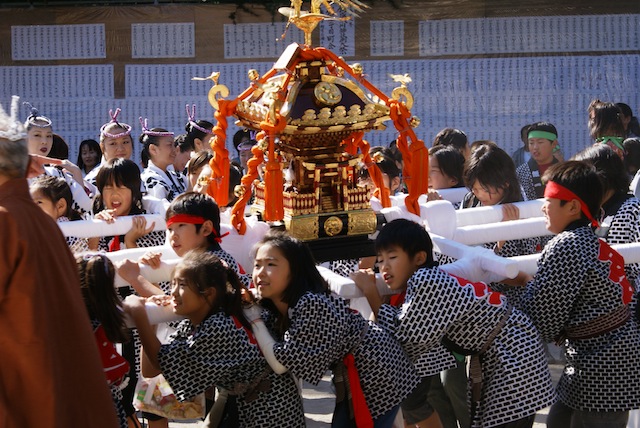
It is still very hot on this November day. Some of my friends living in Saitama, the large prefecture north of Tokyo, have invited me to come and visit them in their city of Kawaguchi for a matsuri, a Japanese traditional festival.
The event is rooted in religion linked to shintô, the Japanese indigenous religion. At matsuri you’ll find a lively atmosphere with parades, giant hana-bi (fireworks), games for children and many food and drink options sold at yatai (mobile food stalls). People like to put on a yukata (a cotton kimono), particularly for summer matsuri, which are the most common. Many matsuri count the parade of a mikoshi — a portable shrine that is supposed to be a divine palanquin — a vehicle for the deity. On this particular matsuri, the mikoshi would be taken out for a parade in the neighborhood.
My friends are eager to show me the event, particularly as I have stayed at their place in Kawaguchi in the past and know several people in the city. I enjoy Japanese matsuri very much and was looking forward to a day of having fun, eating good food and watching the parade; however, my first surprise occurs when I arrive at my friends’ apartment and one of them offers to dress me in a traditional outfit and happi coat, a kind of short cotton kimono especially worn for matsuri parades.
“Why do you want me to dress up?” I ask, confused by the request.
My friend smiles. “It will be fun. Besides, it will help you blend in with the costumed crowd.”
This particular friend owns a kimono shop and sometimes dresses me up in her kimonos just for the pleasure of taking pictures. Because of this I assume her idea of dressing me up in tradition garments is just to help me get into a festive mood. It doesn’t take long for me to realize I assumed wrong.
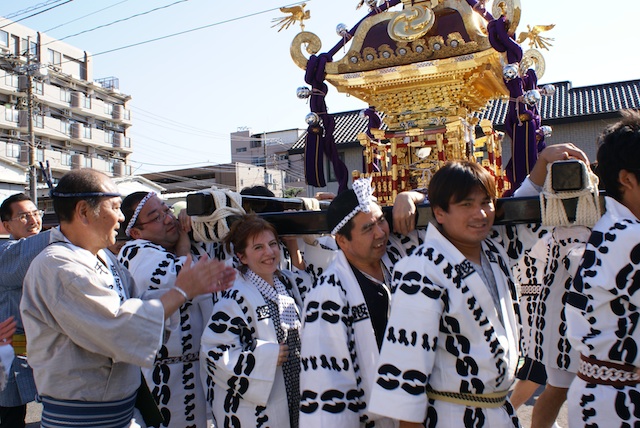
Becoming A Mikoshi Shrine Bearer
My friends’ motives become clear when I am pushed with giggles and encouragement into a group of mikoshi bearers who will be carrying the shrine around the city for the festival. While at first I think it is only for photos, I am soon offered to join the men’s group. And later, when the women take their turn, I am again asked to join and follow the group on their tour of the city. This is quite an unusual invitation for a gaijin (foreigner), particularly for one who doesn’t belong to the community. Another foreigner joins the group, although he has been living in the neighborhood for quite a few years and fully belongs to the mikoshi bearers association. Fortunately, my fellow co-bearers are kind and attentive, taking great care I don’t really carry the weight of the mikoshi the entire time. I am thankful, as the experience is not only completely new to me, but very unexpected.
Japanese mikoshi bearers have the habit of chanting “wasshoi” during each step they take. The original meaning of wasshoi is subject to interpretation, but the word is said in unison with strong conviction by the bearers, to encourage themselves while making the mikoshi shrine move in an up and down motion. The tradition also has the ability to create a commune energy that one can feel deep within oneself. Among that group of bearers I can sense the force of the group, and the fun and happiness they feel in sharing this moment of communion with one another.
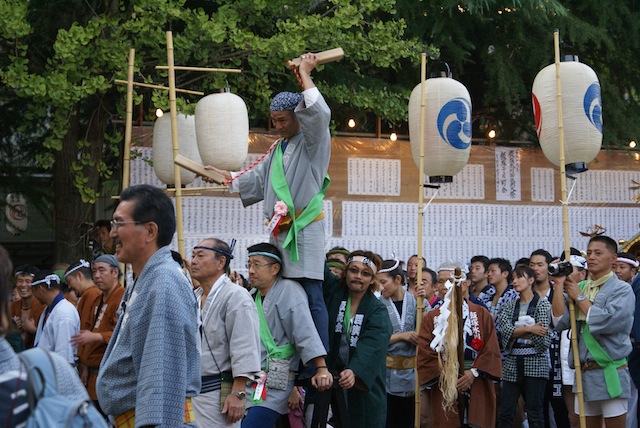
A man encouraging bearers and giving them a rythmn by clapping woodblocks together
Festival Origins
Mikoshi parades have their origins in religion, and the parade does start from and finish in the shintô sanctuary. Shintô is Japan’s indigenous religion; it has strong links with animism, which has a strong respect for the divine forces of nature and the rhythm of seasons and agriculture. Shintô is therefore related to the primal energies of life and Earth. Matsuri are moments of religious expression; but more than that, they are moments when Japanese people make peace with their inner energy. It is now more of an opportunity to forget everyday life, to reunite with neighbors and relatives and get back to one’s roots.
Commencement
After the parade and a few “family portraits” taken by locals with the bearers — which, thanks for my friends, includes me — we are all invited to a lively dinner party at the sanctuary. Japanese take every opportunity they have to enjoy a good dinner and a few drinks, although I’m sure many of the bearers have already hydrated themselves with more adult drinks than water during the festival. The atmosphere is therefore already very animated at the start of the evening. As usual, the dinner starts somewhat formally, with several discourses and many congratulations, all celebrated with many kampai, the Japanese word for toasts and cheers. By the end of the affair, everyone is good and tipsy, with jovial conversations going on around the table.
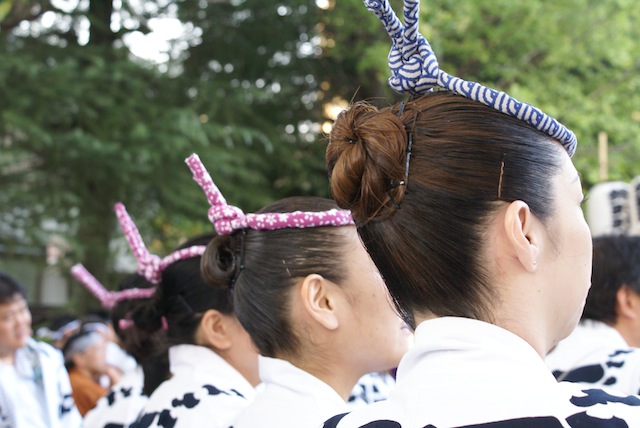
Women mikoshi bearers wear traditional tenugui pieces of cotton clothes, folded in a decorative manner
Looking Back & Getting Involved
The unique experience, which came as a total surprise to me, remains one of my fondest memories of my time in Japan. I was glad to be given the chance to participate in that friendly local matsuri, not in the position of an outsider as I usually do, but as an insider, an opportunity that doesn’t occur every day. Although it is not a common opportunity for a foreigner, it is possible to be part of a matsuri parade during a long term stay by joining a local association focusing on dance, neighbors or culture. This is also a great way befriend locals and get involved in local life. Even in big Japanese cities like Tokyo, neighborhoods function as small villages, and it is great to be able to join in and feel like you’re part of the community.
Extra Scenes From The Festival
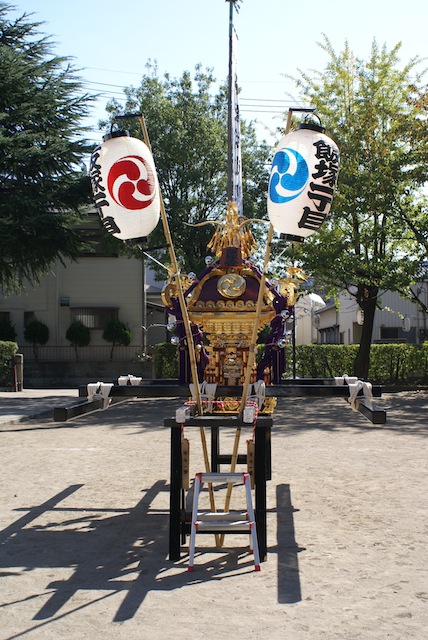

A well-deserved rest after bearing the mikoshi

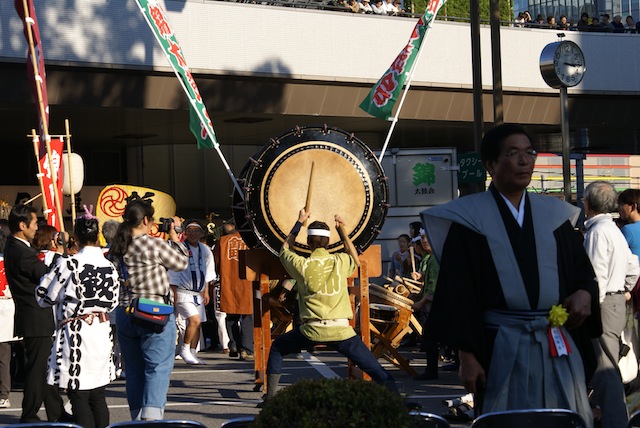
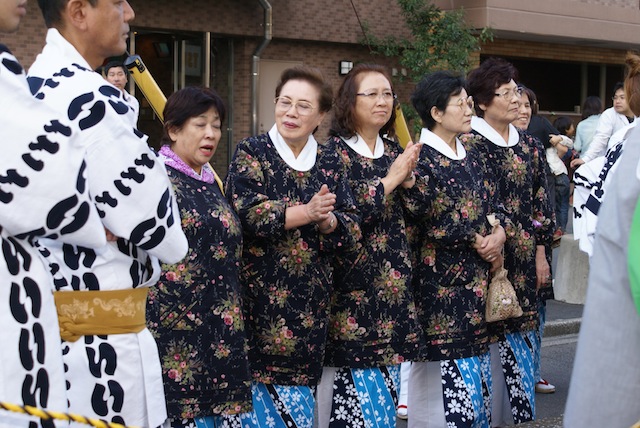
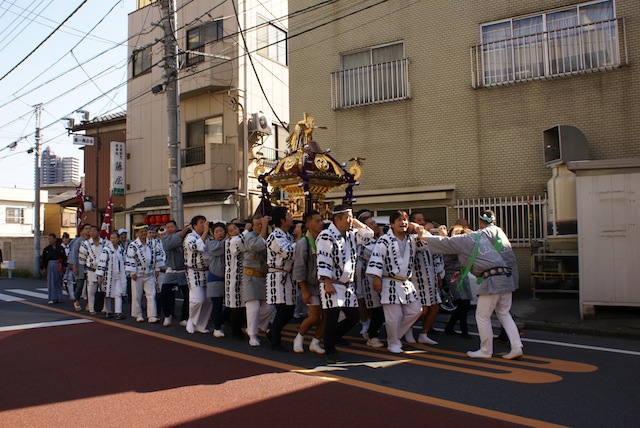

Jessica Festa is the editor of the travel sites Jessie on a Journey (http://jessieonajourney.com) and Epicure & Culture (http://epicureandculture.com). Along with blogging at We Blog The World, her byline has appeared in publications like Huffington Post, Gadling, Fodor’s, Travel + Escape, Matador, Viator, The Culture-Ist and many others. After getting her BA/MA in Communication from the State University of New York at Albany, she realized she wasn’t really to stop backpacking and made travel her full time job. Some of her most memorable experiences include studying abroad in Sydney, teaching English in Thailand, doing orphanage work in Ghana, hiking her way through South America and traveling solo through Europe. She has a passion for backpacking, adventure, hiking, wine and getting off the beaten path.








